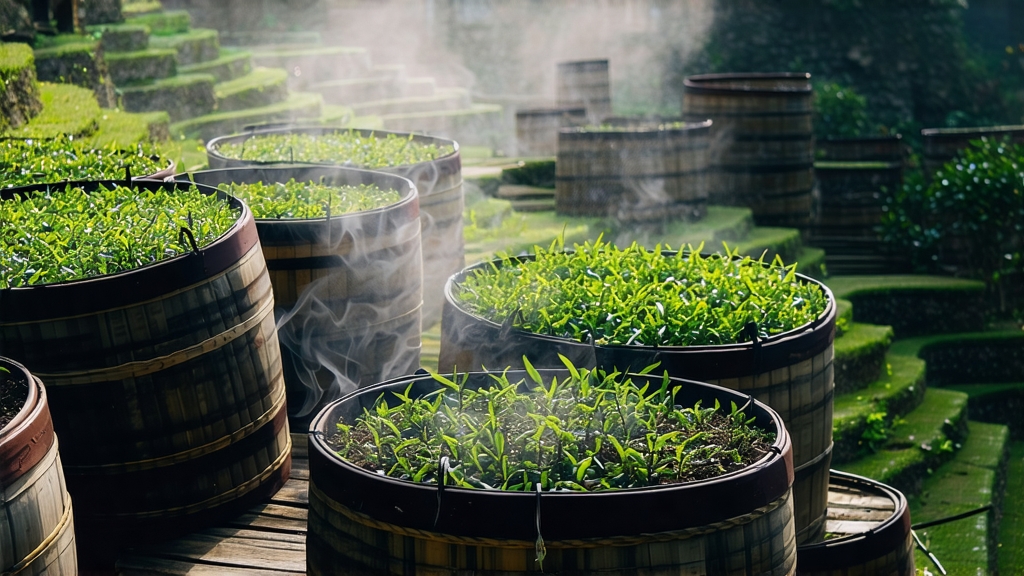
Tucked away in the southern folds of China’s Guangxi Zhuang Autonomous Region, Liu Bao cha has spent four centuries perfecting the art of subtlety. While Pu-erh grabs headlines, Liu Bao quietly ferments in bamboo baskets, acquiring the earthy sweetness that once fueled the caravans of the ancient Tea-Horse Road. Today this dark, velvety tea is emerging from obscurity, offering the global palate a master-class in microbial alchemy, time, and terroir.
Historical footprints
The name Liu Bao literally means “Six Forts,” a reference to the six stockades that protected the small mountain town of Wuzhou during the Ming dynasty. By the late 1500s the tea grown there was already being compressed into tight baskets, loaded onto bamboo rafts, and floated down the Xun River to Guangzhou’s export docks. From Canton it sailed to Southeast Asia where dockworkers in Kuala Lumpur and Singapore discovered that the humid hold of a Chinese junk produced something remarkable: the tea arrived darker, smoother, and oddly refreshing under the equatorial sun. British medical officers in Malaya even listed Liu Bao as a “cooling beverage” in 19th-century hospital ledgers, prescribing it to miners suffering from heatstroke. Thus, long before the concept of post-fermentation was understood, Liu Bao had become the people’s tonic of the South China Sea.
Varietal identity
Liu Bao is not a brand but a protected geographical indication; only leaf plucked within the 48 villages surrounding Wuzhou’s Cangwu county may bear the title. The cultivar of choice is the medium-leaf Yunnan-type Camellia sinensis var. assamica, locally called “Zhong Ye Zhong,” prized for its thick cuticle and high ratio of stem to blade—an anatomical quirk that feeds the microbes during the critical wet-piling phase. Farmers harvest five flushes a year, yet the most coveted material arrives in late April when morning fog lingers long enough to fatten the buds without tipping them into astringency.
Crafting darkness: the double fermentation
Unlike the raw-to-ripe trajectory of Pu-erh, Liu Bao undergoes a two-stage fermentation that begins the moment the leaf leaves the bush. First comes “sha qing,” a brief 280 °C tumble in a bamboo-lined drum that deactivates oxidative enzymes but preserves leaf integrity. While still warm, the tea is rolled on rattan mats until the stems audibly snap, releasing a grassy perfume that quickly folds into something reminiscent of steamed rice. The piles are then transferred to an underground humid room where the signature “wo dui” (wet piling) begins. Workers sprinkle 28 °C river water over 500 kg heaps, cover them with jute sacks, and let thermophilic bacteria feast for 25–35 days. Temperature probes are inserted like acupuncture needles; when the core hits 65 °C the pile is turned, aerated, and re-dampened. This cycle repeats six times until the leaf turns the color of bitter chocolate and exudes the scent of rain-soaked betel nut. The second fermentation is slower: the tea is packed into two-kilogram bamboo baskets lined with untreated banana leaves and stacked in limestone caves whose relative humidity hovers at 85 %. Here, in near darkness, mellow lactic acid bacteria continue to nibble on residual sugars, rounding edges and deepening bass notes for anywhere from three to thirty years. The final leaf is a mottled palette of ebony and rust, fragrant with camphor, ginseng, and the faintest whisper of star anise.
Basket aesthetics
Traditional Liu Bao is sold in “lan cha” form—an open-weave bamboo basket that functions as both shipping vessel and breathing chamber. The weave is tight enough to prevent spillage yet loose enough to allow micro-oxygenation, so the tea continues to evolve on the shelf. Connoisseurs speak of “basket aroma,” a sweet woody note that migrates from bamboo to leaf over decades. Some collectors rotate their baskets quarterly, believing that gravity should not be allowed to settle flavor in only one direction.
The art of brewing
Liu Bao forgives the novice but rewards the attentive. Begin by rinsing 5 g of leaf in a 150 ml Yixing teapot using water just off the boil; the rinse awakens dormant spores and washes away cave dust. The first proper infusion, 15 seconds at 100 °C, pours out the color of black cherry and smells like a walk